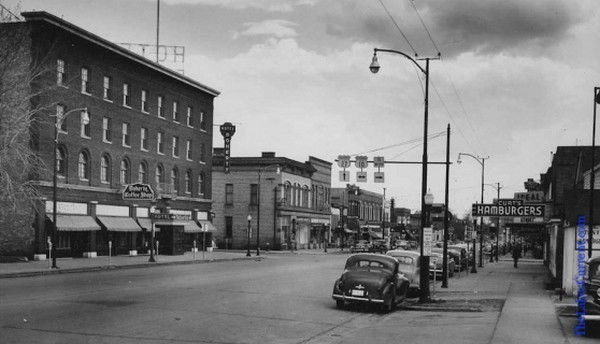
Doherty Hotel, left, and downtown Clare in mid-1930s photo. (Mid-Michigan Community College) PURPLE WITH FEAR! How Did Organized Crime Affect Folks in Clare, Michigan?
November 29, 2012
Leave a Comment
|
||||||||||
| Printer Friendly Story View |
A film documentary that chronicles the Purple Gang organized crime syndicate that operated throughout Michigan in the 1920s and 1930s, was shot on location in Clare.
Central Michigan University broadcast and cinematic arts faculty member and filmmaker Ben Tigner is producer/director of the documentary, "Purple: Organized Crime in a Small Town," that had its debut last summer at the Ideal Theatre in Clare and drew an appreciative crowd last Tuesday in Mt. Pleasant.
The new movie drew a total of 1,300 viewers in two showings in Clare.
A history of Clare states: "The Purple Gang was a notorious group of mostly young Jewish men that controlled a large portion of Michigan, from U.S. 31 to the eastern border of the state.
"The most infamous happening at Clare's Doherty Hotel was on May 14, 1938 when Central Michigan oil promoter Carl Jack Livingston shot and killed Isaiah Leebove in the Tap Room of the hotel. Mr. Leebove was an attorney with ties to the infamous Purple Gang. The home he built in Clare is located just north of downtown."
Susan Field, writing in The Oakland Press of an interview with James Doherty, grandson of original hotel owner A.J. Doherty: "As legend has it, organized crime came to mid-Michigan because of the oil boom between Clare and Mt. Pleasant, Jim Doherty said. Although it was during the Depression, the hotel was a booming business. It was founded in 1924 and today thrives with 157 rooms.
"Leebove was known as an aggressive, gregarious attorney who represented gangsters in New York and came to Michigan to work with oil prospectors, Jim said." Livingston was acquitted on a plea of insanity.
A blogger on the "Gather" site calls the Purples "ruthless terrorists" and gives more detail: "The Purple Gang was called thus because they were considered to be rotten, like "rotting meat" according to a couple of Detroit shopkeepers.
"Four brothers, Abe, Joe, Raymond, and Isadore Bernstein headed this organized crime group on Detroit's east side. The Bernstein brothers grew up as impoverished children of Russian immigrants. The four brothers strongly desired the 'good life,' had expensive tastes, and did not want to work to get what they wanted.
"The group began as youngsters in their Detroit neighborhood and eventually developed a reputation for hijacking, preferring stealing to bootlegging and was brutal in doing their illegal activities. Death was always involved when the Purples were stealing liquor from rival gangs."
As the dominant force of the underworld during the late 1920s, the Purple Gang controlled the city's drug and liquor trade. In 1926, a liquor distributor for the Purple Gang was murdered. The murder resulted in the hiring of Fred "Killer" Burke as a machine gunner. Burke later became famous for his role in the Valentine's Day massacre in Chicago. Burke, along with two other men, ambushed the men suspected of killing the Purple Gang distributor. Al Capone later requested members of the Purple Gang to assist him and his gang in the infamous St. Valentine's Day Massacre.
The Detroit News commented on the end of the gang: "Instead of attempt to restore order to Detroit, local government officials looked the other way, citing it was a way for 'gangsters helpfully eliminating each other.' The end of the Purple Gang was marked by the death of Harry Millman, the last leader of the Purple Gang. The Italian Mafia stepped in to fill the void where the Purple Gang once ruled the underworld in Detroit."
The "Purple" documentary gives viewers a look at the era's values and social norms while exposing the challenges residents faced with organized crime in the community. The film features interviews with those present during The Purple Gang's reign, recounting the gang's use of violence and intimidation as they made their way through Clare.
Tigner, a Coleman, Michigan, native who filmed, edited, assembled and produced the documentary, says he developed an interest in the subject from being raised in the area. He says organized crime is always depicted as something cool, however the brutality of these criminals would never been seen as cool in the modern era.
"I was intrigued by the perception of organized crime and how it differs from reality," Tigner said. "There's no such thing as a "clean hit." If you murder someone, that someone has a brother, an uncle, a friend. Organized crime affects the community."
The three-year research project was funded by CMU's Office of Research and Sponsored Programs through an Early Career Initiative grant. Jim Hageman, interim vice provost for research, says Tigner's approach to the research carried weight with the committee of peers and administrators that voted to award him the grant.
"This was a highly novel approach, particularly as to how a gang like this could affect a small Michigan town," Hageman said. "He had access to some of the people who could give first-hand experience of what was going on back in this era. This was the perfect time to do it."
Tigner says the response he's gotten so far on his Facebook page for the film has been overwhelming. He intends to enter "Purple" into film festivals while working on a license with CMU to distribute the film on DVD.
"We've had 8,300 people visit the website so far," Tigner said. "There's been a lot of local interest, but I think there'd be even more interest if we could get the film into bigger markets. That's my next step."
###
| Printer Friendly Story View |
|
|

Dave Rogers |
|
|
|
Printer-Friendly Story View
0200 Nd: 04-14-2024 d 4 cpr 0
12/31/2020 P3v3-0200-Ad.cfm
SPONSORED LINKS
12/31/2020 drop ads P3v3-0200-Ad.cfm


